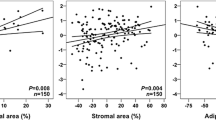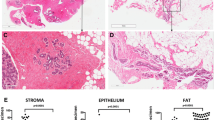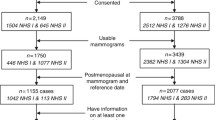Abstract
Mammographic breast density (MBD) is one of the strongest risk factors for breast cancer. Unfortunately, the biologic basis underlying this association is unknown. This study compared aromatase expression or immunoreactivity (IR) in core biopsies from mammographically dense versus non-dense regions of the breast to examine whether estrogen synthesis in the breast is associated with MBD and one possible mechanism through which MBD may influence breast cancer. Eligible participants were 40+ years, had a screening mammogram with visible MBD and no prior cancer or current endocrine therapy. Mammograms were used to identify dense and non-dense regions and ultrasound-guided core biopsies were performed to obtain tissue from these regions. Immunostaining for aromatase employed the streptavidin–biotin amplification method and #677 mouse monoclonal antibody. Aromatase IR was scored in terms of extent and intensity of staining for each cell type (stroma, epithelium, adipocytes) on histologic sections. A modified histological H-score provided quantitation of aromatase IR in each cell type and overall. Repeated measure analyses evaluated average differences (βH) in H-score in dense versus non-dense tissue within and across cell types. Forty-nine women with mean age 50 years (range: 40–82), participated. Aromatase IR was increased in dense (vs. non-dense) tissue in both the stroma (βH = 0.58) and epithelium (βH = 0.12) (P < 0.01). Adipocytes from non-dense tissue, however, had a greater IR compared to those from dense tissue (βH = −0.24, P < 0.01). An overall H-score which integrated results from all cell types demonstrated that aromatase IR was twice as great for dense (mean H-score = 0.90, SD = 0.53) versus non-dense (mean H-score = 0.45, SD = 0.39) breast tissue (βH = 0.45; P < 0.001). Overall, aromatase IR was greater for mammographically dense versus non-dense tissue and may partly explain how MBD influences breast cancer.


Similar content being viewed by others
References
McCormack VA, Highnam R, Perry N, dos Santos Silva I (2007) Comparison of a new and existing method of mammographic density measurement: intramethod reliability and associations with known risk factors. Cancer Epidemiol Biomarkers Prev 16:1148–1154
Martin LJ, Boyd NF (2008) Mammographic density. Potential mechanisms of breast cancer risk associated with mammographic density: hypotheses based on epidemiological evidence. Breast Cancer Res 10:201
Greendale GA, Palla SL, Ursin G, Laughlin GA, Crandall C, Pike MC, Reboussin BA (2005) The association of endogenous sex steroids and sex steroid binding proteins with mammographic density: results from the Postmenopausal Estrogen/Progestin Interventions Mammographic Density Study. Am J Epidemiol 162:826–834
Verheus M, Peeters PH, van Noord PA, van der Schouw YT, Grobbee DE, van Gils CH (2007) No relationship between circulating levels of sex steroids and mammographic breast density: the Prospect-EPIC cohort. Breast Cancer Res 9:R53
McCormack VA, Dowsett M, Folkerd E, Johnson N, Palles C, Coupland B, Holly JM, Vinnicombe SJ, Perry NM, dos Santos Silva I (2009) Sex steroids, growth factors and mammographic density: a cross-sectional study of UK postmenopausal Caucasian and Afro-Caribbean women. Breast Cancer Res 11:R38
Tamimi RM, Byrne C, Colditz GA, Hankinson SE (2007) Endogenous hormone levels, mammographic density, and subsequent risk of breast cancer in postmenopausal women. J Natl Cancer Inst 99:1178–1187
Miller WR, O’Neill J (1987) The importance of local synthesis of estrogen within the breast. Steroids 50:537–548
Dunbier AK, Anderson H, Folkerd E, Ghazoui Z, Smith IE, Ellis MJ, Dowsett M, Neoadjuvant Letrozole Study Group (2009) Expression of estrogen responsive genes in breast cancers correlates with plasma estradiol levels in postmenopausal women. Cancer Res 69:63
Miller WR, Dixon JM, Macfarlane L, Cameron D, Anderson TJ (2003) Pathological features of breast cancer response following neoadjuvant treatment with either letrozole or tamoxifen. Eur J Cancer 39:462–468
Yue W, Wang JP, Hamilton CJ, Demers LM, Santen RJ (1998) In situ aromatization enhances breast tumor estradiol levels and cellular proliferation. Cancer Res 58:927–932
Lipton A, Harvey HA, Demers LM, Hanagan JR, Mulagha MT, Kochak GM, Fitzsimmons S, Sanders SI, Santen RJ (1990) A phase I trial of CGS 16949A. A new aromatase inhibitor. Cancer 65:1279–1285
Brodie A, Lu Q, Long B (1999) Aromatase and its inhibitors. J Steroid Biochem Mol Biol 69:205–210
Morales L, Neven P, Paridaens R (2005) Choosing between an aromatase inhibitor and tamoxifen in the adjuvant setting. Curr Opin Oncol 17:559–565
Santen RJ, Martel J, Hoagland M, Naftolin F, Roa L, Harada N, Hafer L, Zaino R, Santner SJ (1994) Stromal spindle cells contain aromatase in human breast tumors. J Clin Endocrinol Metab 79:627–632
Boyd NF, Martin LJ, Yaffe MJ, Minkin S (2006) Mammographic density: a hormonally responsive risk factor for breast cancer. J Br Menopause Soc 12:186–193
Alowami S, Troup S, Al-Haddad S, Kirkpatrick I, Watson PH (2003) Mammographic density is related to stroma and stromal proteoglycan expression. Breast Cancer Res 5:R129–R135
Li T, Sun L, Miller N, Nicklee T, Woo J, Hulse-Smith L, Tsao MS, Khokha R, Martin L, Boyd N (2005) The association of measured breast tissue characteristics with mammographic density and other risk factors for breast cancer. Cancer Epidemiol Biomarkers Prev 14:343–349
Hawes D, Downey S, Pearce CL, Bartow S, Wan P, Pike MC, Wu AH (2006) Dense breast stromal tissue shows greatly increased concentration of breast epithelium but no increase in its proliferative activity. Breast Cancer Res 8:R24
Stomper PC, Penetrante RB, Edge SB, Arredondo MA, Blumenson LE, Stewart CC (1996) Cellular proliferative activity of mammographic normal dense and fatty tissue determined by DNA S phase percentage. Breast Cancer Res Treat 37:229–236
Khan QJ, Kimler BF, O’Dea AP, Zalles CM, Sharma P, Fabian CJ (2007) Mammographic density does not correlate with Ki-67 expression or cytomorphology in benign breast cells obtained by random periareolar fine needle aspiration from women at high risk for breast cancer. Breast Cancer Res 9:R35
Verheus M, Maskarinec G, Erber E, Steude JS, Killeen J, Hernandez BY, Cline JM (2009) Mammographic density and epithelial histopathologic markers. BMC Cancer 9:182
Harvey JA, Santen RJ, Petroni GR, Bovbjerg VE, Smolkin ME, Sheriff FS, Russo J (2008) Histologic changes in the breast with menopausal hormone therapy use: correlation with breast density, estrogen receptor, progesterone receptor, and proliferation indices. Menopause 15:67–73
Santner SJ, Pauley RJ, Tait L, Kaseta J, Santen RJ (1997) Aromatase activity and expression in breast cancer and benign breast tissue stromal cells. J Clin Endocrinol Metab 82:200–208
Ghosh S, Choudary A, Ghosh S, Musi N, Hu Y, Li R (2009) IKKbeta mediates cell shape-induced aromatase expression and estrogen biosynthesis in adipose stromal cells. Mol Endocrinol 23:662–670
Bulun SE, Lin Z, Imir G, Amin S, Demura M, Yilmaz B, Martin R, Utsunomiya H, Thung S, Gurates B et al (2005) Regulation of aromatase expression in estrogen-responsive breast and uterine disease: from bench to treatment. Pharmacol Rev 57:359–383
Zhou J, Gurates B, Yang S, Sebastian S, Bulun SE (2001) Malignant breast epithelial cells stimulate aromatase expression via promoter II in human adipose fibroblasts: an epithelial-stromal interaction in breast tumors mediated by CCAAT/enhancer binding protein beta. Cancer Res 61:2328–2334
Bulun SE, Price TM, Aitken J, Mahendroo MS, Simpson ER (1993) A link between breast cancer and local estrogen biosynthesis suggested by quantification of breast adipose tissue aromatase cytochrome P450 transcripts using competitive polymerase chain reaction after reverse transcription. J Clin Endocrinol Metab 77:1622–1628
Bulun SE, Simpson ER (1994) Regulation of aromatase expression in human tissues. Breast Cancer Res Treat 30:19–29
Bulun SE, Sharda G, Rink J, Sharma S, Simpson ER (1996) Distribution of aromatase P450 transcripts and adipose fibroblasts in the human breast. J Clin Endocrinol Metab 81:1273–1277
Liu GJ, Wu YS, Brenin D, Yue W, Aiyar S, Gompel A, Wang JP, Tekmal RR, Santen RJ (2008) Development of a high sensitivity, nested Q-PCR assay for mouse and human aromatase. Breast Cancer Res Treat 111:343–351
Santner SJ, Feil PD, Santen RJ (1984) In situ estrogen production via the estrone sulfatase pathway in breast tumors: relative importance versus the aromatase pathway. J Clin Endocrinol Metab 59:29–33
Suzuki T, Nakata T, Miki Y, Kaneko C, Moriya T, Ishida T, Akinaga S, Hirakawa H, Kimura M, Sasano H (2003) Estrogen sulfotransferase and steroid sulfatase in human breast carcinoma. Cancer Res 63:2762–2770
Miki Y, Nakata T, Suzuki T, Darnel AD, Moriya T, Kaneko C, Hidaka K, Shiotsu Y, Kusaka H, Sasano H (2002) Systemic distribution of steroid sulfatase and estrogen sulfotransferase in human adult and fetal tissues. J Clin Endocrinol Metab 87:5760–5768
Vachon CM, Ingle JN, Suman VJ, Scott CG, Gottardt H, Olson JE, Goss PE (2007) Pilot study of the impact of letrozole vs. placebo on breast density in women completing 5 years of tamoxifen. Breast 16:204–210
Cuzick J, Warwick J, Pinney E, Warren RM, Duffy SW (2004) Tamoxifen and breast density in women at increased risk of breast cancer. J Natl Cancer Inst 96:621–628
Cigler T, Tu D, Yaffe MJ, Findlay B, Verma S, Johnston D, Richardson H, Hu H, Qi S, Goss PE (2009) A randomized, placebo-controlled trial (NCIC CTG MAP1) examining the effects of letrozole on mammographic breast density and other end organs in postmenopausal women. Breast Cancer Res Treat. 2009 Dec 6 [Epub ahead of print]
Fabian CJ, Kimler BF, Zalles CM, Khan QJ, Mayo MS, Phillips TA, Simonsen M, Metheny T, Petroff BK (2007) Reduction in proliferation with six months of letrozole in women on hormone replacement therapy. Breast Cancer Res Treat 106:75–84
Mousa NA, Crystal P, Wolfman WL, Bedaiwy MA, Casper RF (2008) Aromatase inhibitors and mammographic breast density in postmenopausal women receiving hormone therapy. Menopause 15:875–884
Acknowledgments
We thank the participants in this study, who provided samples for investigations of the determinants of breast density. This study was financially supported by the Mayo Clinic Breast SPORE, NIH CA116201; NIH K12 RR24151 for the KL2 Clinical and Translational Science Award-Mentored Career Development Program; and Friends for an Earlier Breast Cancer Test.
Author information
Authors and Affiliations
Corresponding author
Electronic supplementary material
Below is the link to the electronic supplementary material.
Rights and permissions
About this article
Cite this article
Vachon, C.M., Sasano, H., Ghosh, K. et al. Aromatase immunoreactivity is increased in mammographically dense regions of the breast. Breast Cancer Res Treat 125, 243–252 (2011). https://doi.org/10.1007/s10549-010-0944-6
Received:
Accepted:
Published:
Issue Date:
DOI: https://doi.org/10.1007/s10549-010-0944-6




